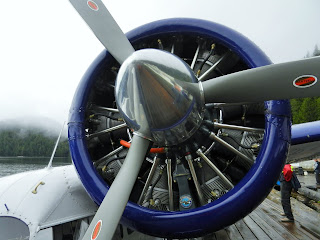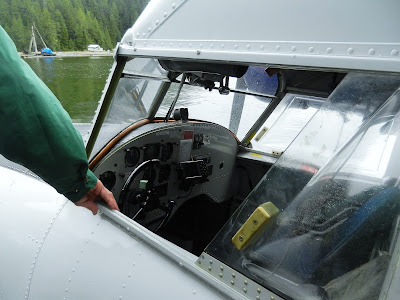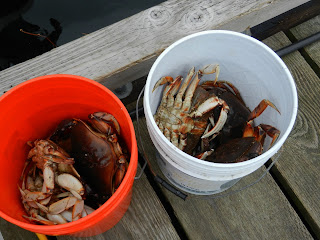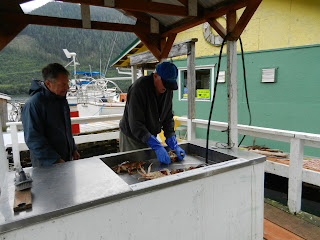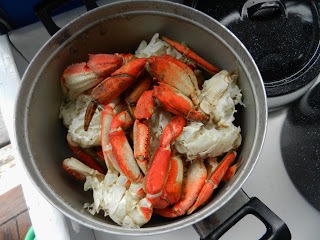After the fortuitist timing of events
at Dawsons Landing, our timing for weather at Duncanby L
anding was very wet and
foggy. After rounding the north end of
Walbran Island, we headed south down Rivers Inlet in the rain and fog, being
careful to avoid the numerous sport fishing boats from the various fishing
lodges in the area: the Good Hope
Cannery Resort, The Duncanby Lodge, Black Gold Lodge, and Goose Bay Lodge among
others.
Good Hope Resort and Duncanby
Landing are both high-end, fly-in fishing lodges.
As we approached Duncanby Landing, the sky let loose with a down pour,
my raingear looked like a miniature waterfall and a river of water ran down the
ramp at the docks. The good news was
that we could dine out at the Duncanby Landing restaurant.
We dried off, changed clothes, and headed for
the restaurant before it got busy with the arrival of the sport fishing
folks.
We shared a salad and delicious
halibut dish served with roasted yellow beats, roasted seasonal potatoes, and
sweet-spicy mango chunks served over the baked fish; the beer on tab from
Whistler’s Brewery was also excellent.
Pleasure boaters seem to appreciate the fact that this sport-fishing resort
welcomes cruisers to stop and enjoy the restaurant and attractive setting; we
were glad to have arrived before the lodge shut down within the next five days for the
season.
The following morning we
continued south into Goose Bay and stopped by Black Gold Lodge to inquire if
they welcome pleasure boats, a resounding NO was the answer.
We continued further into the bay, arriving
at the old cannery which houses the Goose Bay Fishing Lodge. We were greeted by a couple standing on the
dock who said they would be happy to give us a tour of the old cannery buildings
but they were just leaving for Dawsons to get groceries, they would be back in
a couple of hours; “no problem, we will come back later today” we replied.
We found good anchorage in the bay just
across from the cannery and had lunch, baked some cookies, and enjoyed the
afternoon while awaiting their return.
Around 2:40pm we motored over to the cannery dock and tied-up for a few
hours.
Tom the owner was happy to give
us a tour of the facility, actually there are multiple owners of the property,
buildings, and lodge assets including some boats. The accommodations are rustic but improvements
are being made to the buildings and cabins each year thanks to each owner
spending an allotted amount of dedicated time.
The cannery was originally constructed in 1926 and was in operation from
1927 to 1957; at one time 350 people lived and worked here processing and
canning salmon.
Tom showed us through
the main cannery building which included several steam driven motors that used
belts to run other canning equipment of the time. We also toured the wood shop, tool shop, and
cabins once used by the workers of the cannery.
Goose Bay Lodge and cannery is not currently mentioned in our cruising
guide so we asked about the policy for moorage.
We learned that pleasure boaters can tie-up at the dock overnight for a
nominal fee, all funds received go towards improving the cannery site. A drop box for payment is located at the end
of the ramp and is on the “honor system.”
Instructions for visitors is also posted at the end of the ramp, moorage
is on a first-come, first-serve basis.
In addition to the interesting cannery site, visitors are welcome to
hike the 1-mile trail to the dam located above the cannery but should be “bear
aware” and take the appropriate precautions.
We thanked Tom for his time and departed Goose Bay around 4pm for the
two-hour journey to Millbrook Cove in Smith Sound, a good position for the morning
push around dreaded Cape Caution.
 |
| Rain and Fog coming into Duncanby Landing |
 |
| Duncanby Landing Fishing Lodge & Restaurant |
 |
| Duncanby Landing Fishing Lodge |
 |
| Dinner with a View, Duncanby Landing Restaurant |
 |
| Delicious Dinners at Duncanby Landing |
 |
| The Old Cannery - Goose Bay Fishing Lodge |
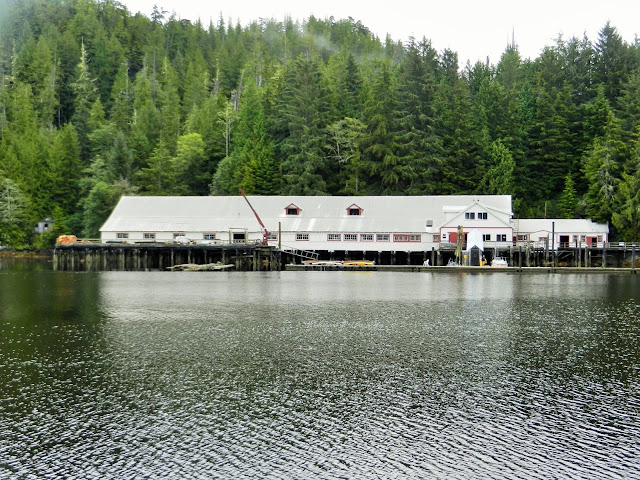 |
| Goose Bay Cannery Building |
 |
| Cannery Buildings, Goose Bay |
 |
| Steam-driven Motors |
 |
| Our Cannery Tour |
 |
| Cannery Housing (now guest cabins) |
 |
| Got d' Fever at Goose Bay Fishing Lodge & Cannery |






